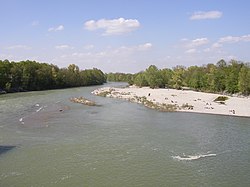Lech (river)
| Lech | |
|---|---|
 | |
| Physical characteristics | |
| Mouth | Danube |
| Length | 264 km |
The Lech (Latin: Licus, Licca) is a river in Austria and Germany. It is a right tributary of the Danube and 264 km in length, with a drainage basin of 2,550 sq. miles. Its source is located in the Austrian state of Vorarlberg, where the river rises from the Formarinsee (a lake) in the Alps at an altitude of 6,120 ft. It flows in a north-north-easterly direction and crosses the German border forming the Lechfall, a 12 m high waterfall; afterwards the river enters a narrow gorge (Lechschlucht). Leaving the alps, it enters the plains of the Allgäu at Füssen (2,580 ft.) in the German state of Bavaria, where it used to form the historic boundary with Swabia, runs through the city of Füssen and behind through the Forggensee (a man-made lake which is drained in winter ready for the next snow melt). Here, it forms rapids and a fall.
The river flows further northwards through a region called the Lechrain and passes the cities of Schongau, Landsberg, Augsburg (where it receives the Wertach) and Rain before entering the Danube River just below Donauwörth (1,330 ft). It is not navigable, owing to its torrential character and the gravel beds which choke its channel. There is a particularly magnificent view of the Lech valley from Neuschwanstein Castle, near Füssen.
On more than one occasion, historic events have been decided on the banks of this river.
- In 278 or Roman emperor Probus vanquished a bigger invasion force of Burgundians and Vandals, which had been raiding the Roman province of Rhaetia.
- At Lechfeld, a stony plain between the Lech and the Wertach, near Augsburg, Otto I defeated the Magyars in August 955.
- In Battle of Rain in April 1632, Gustavus Adolphus of Sweden defeated and mortally wounded Johan Tzerclaes, Count of Tilly.
-
The river Lech in Augsburg
-
The river Lech, in the background the city of Landsberg



